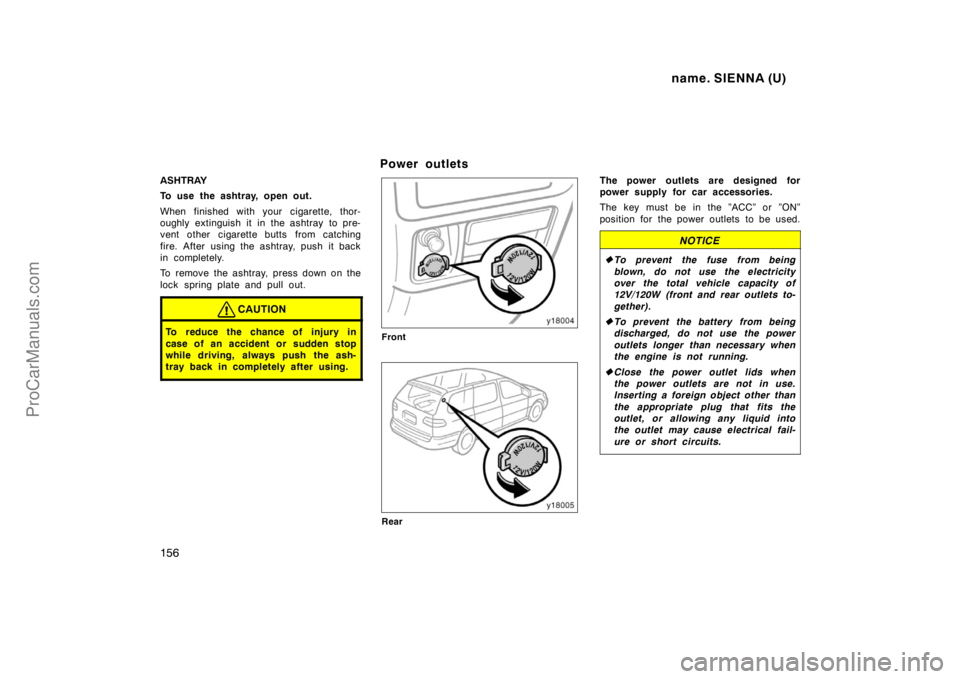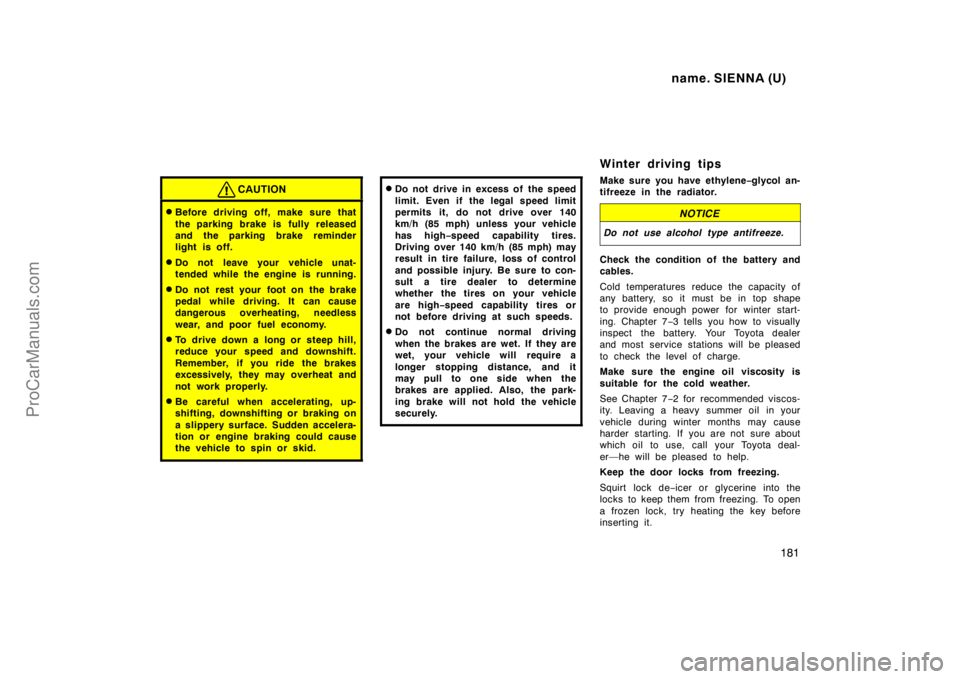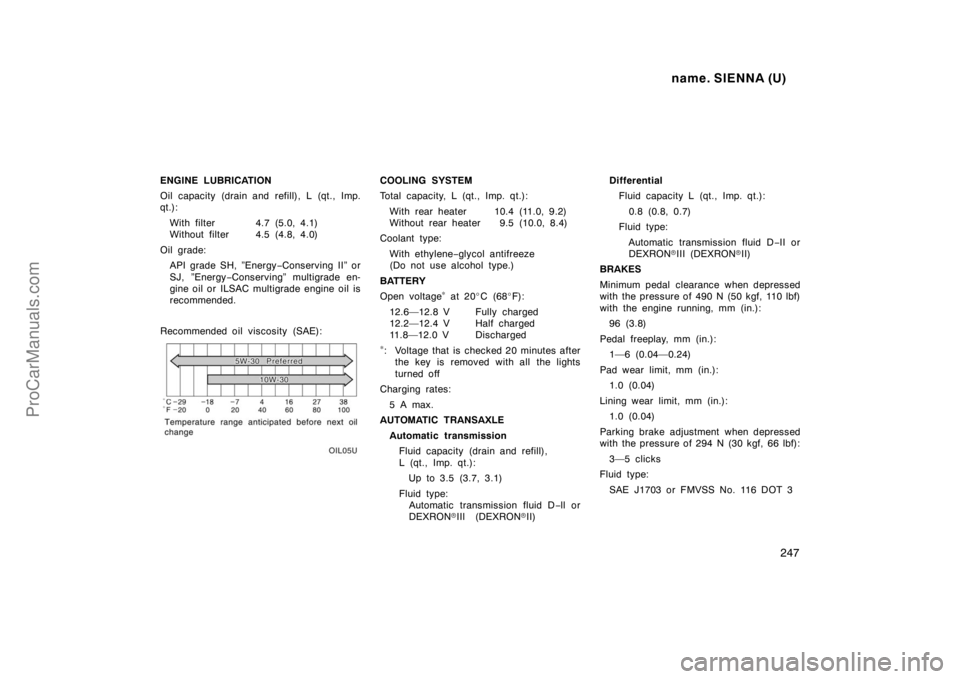Page 156 of 261

name. SIENNA (U)
156
ASHTRAY
To use the ashtray, open out.
When finished with your cigarette, thor-
oughly extinguish it in the ashtray to pre-
vent other cigarette butts from catching
fire. After using the ashtray, push it back
in completely.
To remove the ashtray, press down on the
lock spring plate and pull out.
CAUTION
To reduce the chance of injury in
case of an accident or sudden stop
while driving, always push the ash-
tray back in completely after using.
Power outlets
Front
Rear
The power outlets are designed for
power supply for car accessories.
The key must be in the ”ACC” or ”ON”
position for the power outlets to be used.
NOTICE
�To prevent the fuse from being
blown, do not use the electricity
over the total vehicle capacity of
12V/120W (front and rear outlets to-
gether).
�To prevent the battery from being
discharged, do not use the power
outlets longer than necessary when
the engine is not running.
�Close the power outlet lids when
the power outlets are not in use.
Inserting a foreign object other than
the appropriate plug that fits the
outlet, or allowing any liquid into
the outlet may cause electrical fail-
ure or short circuits.
ProCarManuals.com
Page 181 of 261

name. SIENNA (U)
181
CAUTION
�Before driving off, make sure that
the parking brake is fully released
and the parking brake reminder
light is off.
�Do not leave your vehicle unat-
tended while the engine is running.
�Do not rest your foot on the brake
pedal while driving. It can cause
dangerous overheating, needless
wear, and poor fuel economy.
�To drive down a long or steep hill,
reduce your speed and downshift.
Remember, if you ride the brakes
excessively, they may overheat and
not work properly.
�Be careful when accelerating, up-
shifting, downshifting or braking on
a slippery surface. Sudden accelera-
tion or engine braking could cause
the vehicle to spin or skid.
�Do not drive in excess of the speed
limit. Even if the legal speed limit
permits it, do not drive over 140
km/h (85 mph) unless your vehicle
has high−speed capability tires.
Driving over 140 km/h (85 mph) may
result in tire failure, loss of control
and possible injury. Be sure to con-
sult a tire dealer to determine
whether the tires on your vehicle
are high−speed capability tires or
not before driving at such speeds.
�Do not continue normal driving
when the brakes are wet. If they are
wet, your vehicle will require a
longer stopping distance, and it
may pull to one side when the
brakes are applied. Also, the park-
ing brake will not hold the vehicle
securely.
Winter driving tips
Make sure you have ethylene−glycol an-
tifreeze in the radiator.
NOTICE
Do not use alcohol type antifreeze.
Check the condition of the battery and
cables.
Cold temperatures reduce the capacity of
any battery, so it must be in top shape
to provide enough power for winter start-
ing. Chapter 7−3 tells you how to visually
inspect the battery. Your Toyota dealer
and most service stations will be pleased
to check the level of charge.
Make sure the engine oil viscosity is
suitable for the cold weather.
See Chapter 7−2 for recommended viscos-
ity. Leaving a heavy summer oil in your
vehicle during winter months may cause
harder starting. If you are not sure about
which oil to use, call your Toyota deal-
er—he will be pleased to help.
Keep the door locks from freezing.
Squirt lock de−icer or glycerine into the
locks to keep them from freezing. To open
a frozen lock, try heating the key before
inserting it.
ProCarManuals.com
Page 247 of 261

name. SIENNA (U)
247
ENGINE LUBRICATION
Oil capacity (drain and refill), L (qt., Imp.
qt.):
With filter 4.7 (5.0, 4.1)
Without filter 4.5 (4.8, 4.0)
Oil grade:
API grade SH, ”Energy−Conserving II” or
SJ, ”Energy−Conserving” multigrade en-
gine oil or ILSAC multigrade engine oil is
recommended.
Recommended oil viscosity (SAE):COOLING SYSTEM
Total capacity, L (qt., Imp. qt.):
With rear heater 10.4 (11.0, 9.2)
Without rear heater 9.5 (10.0, 8.4)
Coolant type:
With ethylene−glycol antifreeze
(Do not use alcohol type.)
BATTERY
Open voltage
∗ at 20�C (68�F):
12.6—12.8 V Fully charged
12.2—12.4 V Half charged
11.8—12.0 V Discharged
∗: Voltage that is checked 20 minutes after
the key is removed with all the lights
turned off
Charging rates:
5 A max.
AUTOMATIC TRANSAXLE
Automatic transmission
Fluid capacity (drain and refill),
L (qt., Imp. qt.):
Up to 3.5 (3.7, 3.1)
Fluid type:
Automatic transmission fluid D−ll or
DEXRON�IIl (DEXRON�II)Differential
Fluid capacity L (qt., Imp. qt.):
0.8 (0.8, 0.7)
Fluid type:
Automatic transmission fluid D−II or
DEXRON�III (DEXRON�II)
BRAKES
Minimum pedal clearance when depressed
with the pressure of 490 N (50 kgf, 110 lbf)
with the engine running, mm (in.):
96 (3.8)
Pedal freeplay, mm (in.):
1—6 (0.04—0.24)
Pad wear limit, mm (in.):
1.0 (0.04)
Lining wear limit, mm (in.):
1.0 (0.04)
Parking brake adjustment when depressed
with the pressure of 294 N (30 kgf, 66 lbf):
3—5 clicks
Fluid type:
SAE J1703 or FMVSS No. 116 DOT 3
ProCarManuals.com